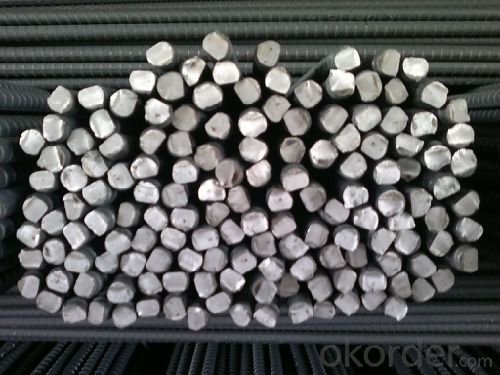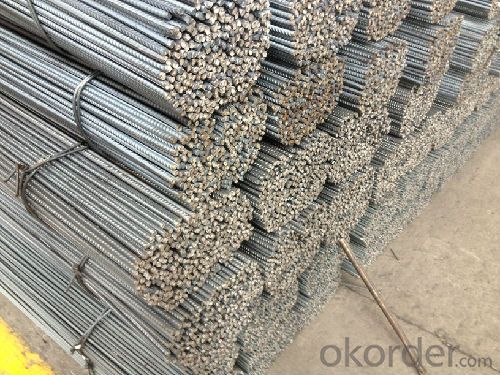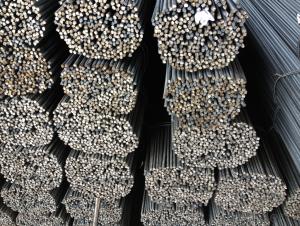Hot Rolled Deformed Steel Rebars ASTM GR40, GR60
- Loading Port:
- Shanghai
- Payment Terms:
- TT or LC
- Min Order Qty:
- 100 m.t.
- Supply Capability:
- 200000 m.t./month
OKorder Service Pledge
OKorder Financial Service
You Might Also Like
OKorder is offering Hot Rolled Deformed Steel Rebars ASTM GR40, GR60 at great prices with worldwide shipping. Our supplier is a world-class manufacturer of steel, with our products utilized the world over. OKorder annually supplies products to African, South American and Asian markets. We provide quotations within 24 hours of receiving an inquiry and guarantee competitive prices.
Product Applications:
Hot Rolled Deformed Steel Rebars ASTM GR40, GR60 are ideal for structural applications and are widely used in the construction of buildings and bridges, and the manufacturing, petrochemical, and transportation industries.
Product Advantages:
OKorder's Hot Rolled Deformed Steel Rebars ASTM GR40, GR60 are durable, strong, and wide variety of sizes.
Main Product Features:
· Premium quality
· Prompt delivery & seaworthy packing (30 days after receiving deposit)
· Can be recycled and reused
· Mill test certification
· Professional Service
· Competitive pricing
Product Specifications:
Manufacture: Hot rolled
Grade: Gr40,Gr60 etc
Certificates: ISO, SGS, BV, CIQ
Length: 6m – 12m, as per customer request
Packaging: Export packing, nude packing, bundled
Deformed Steel Bar | ||
Diameter (MM) | Cross Sectional Area (MM2) | Theorectical Weight (KG/M) |
6 | 28.27 | 0.222 |
8 | 50.27 | 0.395 |
10 | 78.54 | 0.617 |
12 | 113.1 | 0.888 |
14 | 153.9 | 1.21 |
16 | 201.1 | 1.58 |
18 | 254.5 | 2 |
20 | 314.2 | 2.47 |
22 | 380.1 | 2.98 |
25 | 490.9 | 3.85 |
28 | 615.8 | 4.83 |
32 | 804.2 | 6.31 |
36 | 1018 | 7.99 |
40 | 1257 | 9.87 |
FAQ:
Q1: Why buy Materials & Equipment from OKorder.com?
A1: All products offered byOKorder.com are carefully selected from China's most reliable manufacturing enterprises. Through its ISO certifications, OKorder.com adheres to the highest standards and a commitment to supply chain safety and customer satisfaction.
Q2: How do we guarantee the quality of our products?
A2: We have established an advanced quality management system which conducts strict quality tests at every step, from raw materials to the final product. At the same time, we provide extensive follow-up service assurances as required.
Q3: what is the difference between actual weight and theoretical weight?
A3: All the section steel has two weights: actual weight and theoretical weight. Actual weight is the weighing out when the product delivered from the mill. Theoretical weight is calculated by pieces. The invoice can be based on each of them as your request.
Images:


- Q:How do steel rebars affect the overall constructability of a project?
- The overall constructability of a project is greatly influenced by steel rebars. These rebars, also known as reinforcing bars, play a vital role in improving the strength, durability, and stability of concrete structures. They are essential in mitigating the tensile forces that concrete alone cannot bear, thereby increasing the overall load-bearing capacity of the structure. To begin with, steel rebars simplify the construction process by providing a framework for pouring and shaping concrete. They serve as a skeletal structure that holds the concrete in place during the curing process, ensuring proper setting and desired shaping. This contributes to the efficiency of construction projects, allowing for faster concrete placement and reducing the risk of structural deformities. Furthermore, rebars enhance the structural integrity of the project. By reinforcing the concrete, they enhance its ability to resist cracking, bending, and breaking under different loads and environmental conditions. This added strength and resilience make the structure more durable and reduce the need for frequent repairs or maintenance, ultimately saving time and costs in the long term. In addition to strength and durability, steel rebars also contribute to the constructability of a project by enabling flexibility in design. Architects and engineers have the freedom to create complex and innovative structures, such as high-rise buildings, bridges, and tunnels, that require high load-bearing capacities. The versatility of rebars allows for the construction of structures with unique shapes, curves, and spans, expanding the possibilities of architectural design. Moreover, steel rebars facilitate constructability by enabling the construction of large-scale projects. They allow for the creation of reinforced concrete elements, such as columns, beams, and slabs, capable of supporting heavy loads and distributing them evenly throughout the structure. This capability is particularly crucial for projects that require significant weight-bearing capacity, such as industrial buildings or infrastructure projects. In conclusion, steel rebars have a profound impact on the constructability of a project. They simplify the construction process, enhance structural integrity, enable flexibility in design, and facilitate the construction of large-scale projects. By incorporating rebars into concrete structures, construction professionals can ensure that their projects are stronger, more durable, and better equipped to withstand various loads and environmental conditions.
- Q:What are the guidelines for proper spacing and lapping of steel rebars in concrete structures?
- The guidelines for proper spacing and lapping of steel rebars in concrete structures vary depending on the specific design and structural requirements. However, some general recommendations exist. The rebars should be adequately spaced to ensure proper concrete cover, allowing for corrosion protection and sufficient bond strength. Typically, the minimum spacing between parallel rebars is around 1.5 times the diameter of the larger bar or 25 mm (1 inch), whichever is greater. Lapping, or overlapping, of rebars is necessary to create a continuous load path. The length of the overlap depends on the design and the type of rebar connection being used. It is important to follow the specifications provided by structural engineers and adhere to local building codes to ensure the proper spacing and lapping of rebars in concrete structures.
- Q:How do steel rebars prevent concrete structures from collapsing?
- Reinforcement and strength are provided to concrete structures by steel rebars, which prevent their collapse. Concrete is capable of withstanding forces that compress or squeeze it, making it a strong material. However, it is not able to withstand forces that pull it apart, resulting in weakness in tension. When subjected to tension, concrete may crack and ultimately fail. To counteract these tensile forces and offer additional strength, reinforcement bars, also known as steel rebars, are typically embedded within concrete structures. These rebars are made of high-strength steel and are strategically placed to resist the pulling forces. When external forces, such as wind or seismic activity, impact a concrete structure, the rebars assist in distributing the load and resisting tension. As the concrete attempts to separate, the rebars hold it together, preventing the propagation of cracks and maintaining the structure's integrity. Additionally, the rebars enhance the overall durability and lifespan of the concrete structure. By reinforcing the concrete, they mitigate the effects of shrinkage and thermal expansion, which can lead to cracks over time. Consequently, a more stable and resilient structure is achieved, capable of withstanding various environmental and structural stresses. In conclusion, steel rebars are crucial in averting the collapse of concrete structures, as they provide the necessary reinforcement and strength to resist tension. They elevate the structural integrity, durability, and safety of concrete structures, ensuring their ability to withstand demands and fulfill their intended purpose for extended periods.
- Q:Can steel rebars be used in the construction of sports stadiums or arenas?
- Yes, steel rebars can certainly be used in the construction of sports stadiums or arenas. Steel rebars are commonly utilized as reinforcement in concrete structures, and their high tensile strength and durability make them well-suited for large-scale projects like sports stadiums. The rebars provide additional support and stability to the concrete, helping to withstand the immense loads and forces that stadiums and arenas may experience during events. Additionally, steel rebars can be easily shaped and bent to fit the specific needs and design requirements of the structure, making them a versatile choice for construction purposes.
- Q:How do steel rebars help in preventing cracks in concrete?
- The reinforcement of steel rebars is essential for preventing cracks in concrete and adding strength to the structure. Concrete is strong in compression but weak in tension, meaning it can withstand forces that push or compress it, but it is prone to cracking under pulling or bending forces. To counteract this weakness, steel rebars are embedded within the concrete. They act as a framework, distributing tensile forces evenly throughout the material and preventing the formation and spread of cracks. Additionally, rebars reinforce the structure, increasing its resistance to bending, shearing, and external forces. Furthermore, steel rebars enhance the overall structural integrity of the concrete, thus preventing cracks. During the drying and curing process, concrete tends to shrink and crack. However, with the presence of rebars, the tensile forces caused by shrinkage are absorbed by the steel, reducing or eliminating the formation of cracks. Moreover, steel rebars provide resistance against temperature changes and external loads, which also helps prevent cracks in concrete. They control the expansion and contraction of the material due to temperature fluctuations, minimizing the risk of cracking. Additionally, rebars reinforce the concrete against heavy loads, such as those from traffic or seismic activity, ensuring the structure remains intact and free from cracks. In conclusion, steel rebars are crucial in preventing cracks in concrete by reinforcing the material, distributing forces, absorbing tensile stresses, and enhancing structural integrity. Their presence significantly improves the durability and longevity of concrete structures, making them more resistant to cracking and ensuring their stability over time.
- Q:What are the common manufacturing processes for steel rebars?
- The common manufacturing processes for steel rebars involve several steps to ensure the production of high-quality and durable reinforcement bars. These processes typically include: 1. Melting: The first step in manufacturing steel rebars is melting the raw materials, which usually consist of iron ore, coal, and limestone, in a blast furnace. This process produces molten iron that is then further refined to remove impurities. 2. Casting: Once the molten iron is refined, it is poured into molds to create large billets or blooms. These molds are often called continuous casting machines, where the molten iron solidifies into a rectangular shape. 3. Rolling: The solidified billets or blooms are then heated and passed through rolling mills. The rolling process involves compressing the steel between a series of rollers to reduce its thickness and shape it into the desired dimensions of rebars. This process also helps improve the mechanical properties and eliminate any internal defects or impurities. 4. Quenching and Tempering: After the initial rolling process, the rebars may undergo quenching and tempering. Quenching involves rapidly cooling the steel bars by immersing them in water or oil. This step increases the hardness of the rebars, making them more resistant to deformation and wear. Tempering follows, which involves reheating the quenched bars to a specific temperature and then cooling them slowly. Tempering helps remove internal stresses and improves the toughness of the rebars. 5. Cutting and Coiling: Once the bars have been rolled and heat-treated, they are cut to the desired lengths using cutting machines. The cut rebars are then coiled into bundles or stacked for storage and transportation. 6. Surface Treatment: To enhance the corrosion resistance of rebars, manufacturers often apply a protective coating or surface treatment. This can involve hot-dip galvanizing, where the rebars are immersed in molten zinc to form a zinc coating, or epoxy coating, where a layer of epoxy resin is applied to the rebars. It is important to note that these manufacturing processes may vary depending on the specific requirements and standards set by different countries and industries. However, the aforementioned steps provide a general overview of the common processes involved in manufacturing steel rebars.
- Q:How are steel rebars tested for quality and strength?
- Steel rebars are tested for quality and strength through a series of standardized tests. These tests ensure that the rebars meet the required standards and can withstand the expected loads and stresses. One common test is the Tensile Test, which measures the maximum amount of stress a rebar can withstand before it breaks. In this test, a sample rebar is pulled until it fractures, and the force required to break it is measured. This test provides valuable information about the rebar's ultimate tensile strength, yield strength, and elongation. Another important test is the Bend Test, which evaluates the rebar's ductility and ability to withstand bending without breaking. In this test, a sample rebar is bent to a specific angle, and any cracks or fractures are closely examined. The rebar is deemed acceptable if it doesn't show any signs of failure. Additionally, Chemical Analysis is performed to determine the chemical composition of the rebar. This test ensures that the steel meets the required chemical composition standards, as different compositions can affect the rebar's strength and durability. Furthermore, the Dimensional Test checks the dimensions, weight, and shape of the rebar to ensure they comply with the specified standards. Any deviations from the required measurements can compromise the rebar's structural integrity. Moreover, the rebar's Surface Condition is examined visually to assess any signs of rust, cracks, or other defects that may affect its performance. Proper surface condition is crucial as it ensures good bonding with the surrounding concrete. Finally, some rebars undergo Non-Destructive Testing such as ultrasonic testing or magnetic particle inspection to detect any hidden defects or cracks that may not be visible to the naked eye. Overall, these testing methods are employed to ensure that steel rebars have the required quality and strength to be used in construction projects, providing the necessary reinforcement for reinforced concrete structures.
- Q:Are steel rebars suitable for use in structures with high impact resistance requirements?
- High tensile strength and the ability to withstand heavy loads make steel rebars a common choice in construction. However, they may not be suitable for structures with high impact resistance requirements. Although steel rebars are strong, they do not possess the same level of impact resistance as materials like fiberglass or carbon fiber. For structures that are exposed to heavy impact loads, such as bridges, earthquake-resistant buildings, or structures at risk of collisions with heavy machinery or vehicles, alternative materials may be more appropriate. For instance, fiberglass rebars offer improved impact resistance due to their flexibility and capacity to absorb energy without breaking. Moreover, they have a higher strength-to-weight ratio compared to steel rebars. In contrast, carbon fiber rebars have exceptional impact resistance and are commonly utilized in aerospace and military applications. In conclusion, while steel rebars are reliable for many structural purposes, structures requiring high impact resistance may benefit from the use of alternative materials like fiberglass or carbon fiber rebars. It is crucial to carefully evaluate the specific needs and demands of the structure to ensure both its durability and safety.
- Q:What is the ductility of steel rebars?
- The ductility of steel rebars refers to its ability to deform under tension without fracturing. Steel rebars are known for their high ductility, allowing them to withstand significant bending and stretching without breaking. This property makes them ideal for reinforcing concrete structures, where they can absorb and distribute loads effectively.
- Q:What is the corrosion resistance of steel rebars?
- The corrosion resistance of steel rebars is generally high due to the presence of a protective oxide layer on the surface of the steel. However, in certain environments, such as those with high levels of moisture or exposure to corrosive substances, the rebars may be susceptible to corrosion. Therefore, additional measures such as proper concrete cover, epoxy coating, or galvanization are often employed to enhance the corrosion resistance of steel rebars.
1. Manufacturer Overview |
|
|---|---|
| Location | |
| Year Established | |
| Annual Output Value | |
| Main Markets | |
| Company Certifications | |
2. Manufacturer Certificates |
|
|---|---|
| a) Certification Name | |
| Range | |
| Reference | |
| Validity Period | |
3. Manufacturer Capability |
|
|---|---|
| a)Trade Capacity | |
| Nearest Port | |
| Export Percentage | |
| No.of Employees in Trade Department | |
| Language Spoken: | |
| b)Factory Information | |
| Factory Size: | |
| No. of Production Lines | |
| Contract Manufacturing | |
| Product Price Range | |
Send your message to us
Hot Rolled Deformed Steel Rebars ASTM GR40, GR60
- Loading Port:
- Shanghai
- Payment Terms:
- TT or LC
- Min Order Qty:
- 100 m.t.
- Supply Capability:
- 200000 m.t./month
OKorder Service Pledge
OKorder Financial Service
Similar products
New products
Hot products
Related keywords





























